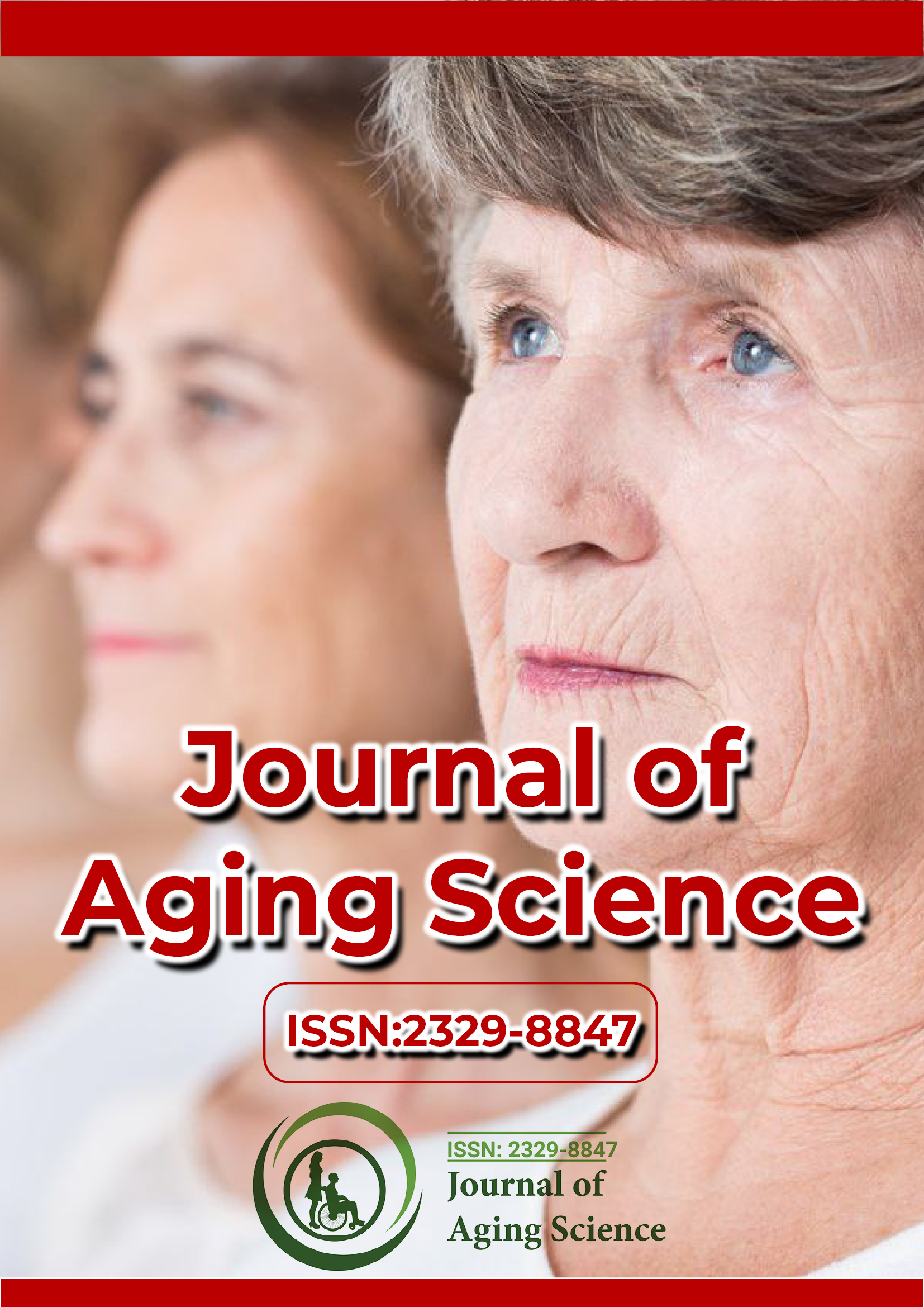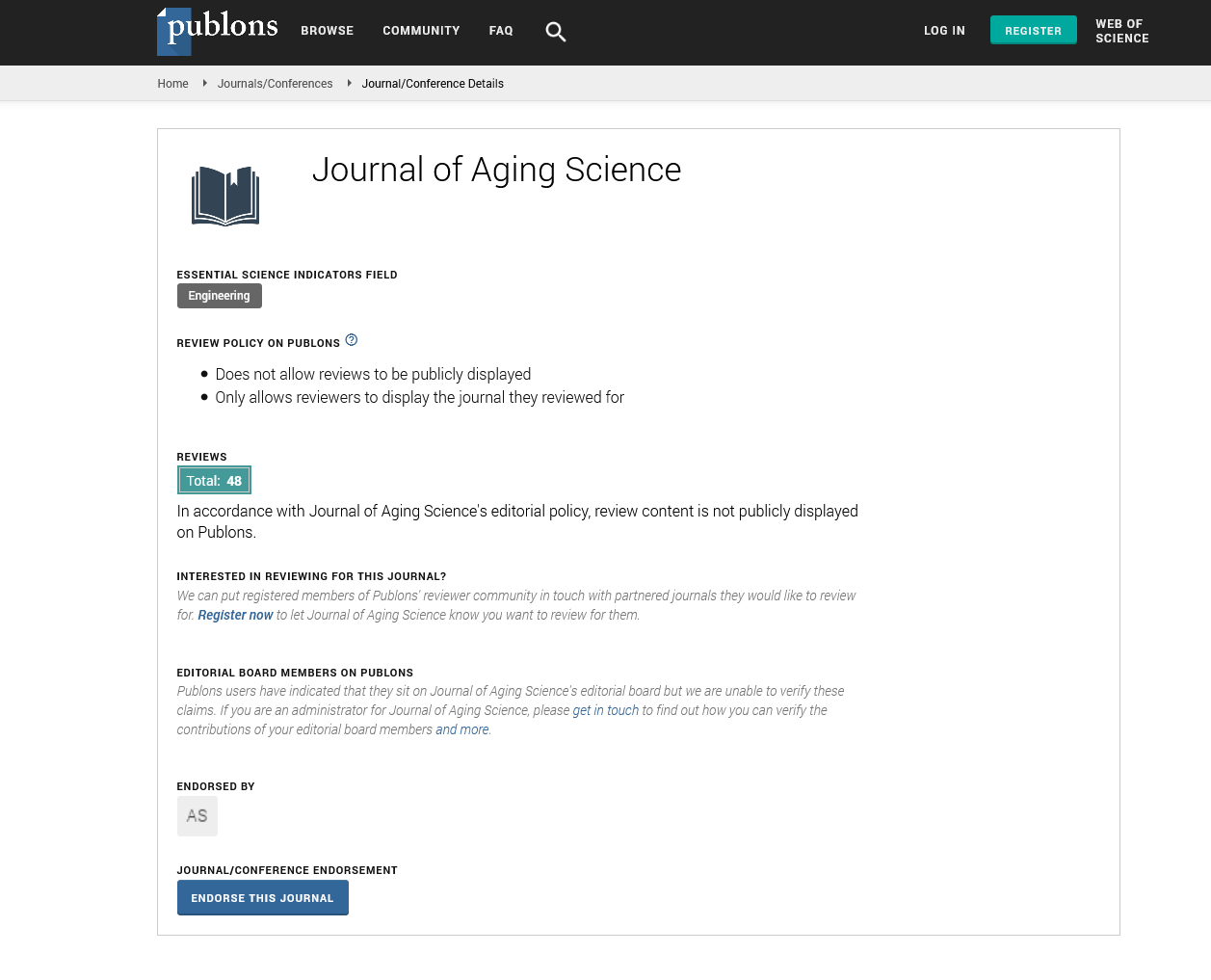Indexed In
- Open J Gate
- Academic Keys
- JournalTOCs
- ResearchBible
- RefSeek
- Hamdard University
- EBSCO A-Z
- OCLC- WorldCat
- Publons
- Geneva Foundation for Medical Education and Research
- Euro Pub
- Google Scholar
Useful Links
Share This Page
Journal Flyer

Open Access Journals
- Agri and Aquaculture
- Biochemistry
- Bioinformatics & Systems Biology
- Business & Management
- Chemistry
- Clinical Sciences
- Engineering
- Food & Nutrition
- General Science
- Genetics & Molecular Biology
- Immunology & Microbiology
- Medical Sciences
- Neuroscience & Psychology
- Nursing & Health Care
- Pharmaceutical Sciences
Commentary - (2025) Volume 13, Issue 2
Metabolic Adaptations in Aging and Their Role in Longevity
Daniel Huber*Received: 28-Mar-2025, Manuscript No. JASC-25-28625; Editor assigned: 31-Mar-2025, Pre QC No. JASC-25-28625 (PQ); Reviewed: 07-Apr-2025, QC No. JASC-25-28625; Revised: 14-Apr-2025, Manuscript No. JASC-25-28625 (R); Published: 28-Apr-2025, DOI: 10.35248/2329-8847.25.13.409
Description
Aging is a complex biological process characterized by a gradual decline in physiological functions, increased vulnerability to diseases and metabolic alterations. Metabolic adaptations during aging plays an important role in determining healthspan and longevity. The efficiency of energy metabolism, mitochondrial function, nutrient sensing pathways and hormonal regulation are key determinants of how organisms age. Understanding these metabolic adaptations provides insight into potential interventions that can promote longevity and mitigate agerelated diseases.
Metabolic changes in aging
As individuals age, their metabolic processes undergo significant changes, affecting energy production, glucose regulation, lipid metabolism and protein synthesis. Some of the primary metabolic adaptations observed in aging include:
Decline in mitochondrial function: Mitochondria are necessary for energy production through oxidative phosphorylation. However, with aging:
• Mitochondrial efficiency declines, leading to reduced ATP production.
• There is an increase in Reactive Oxygen Species (ROS) generation, contributing to oxidative damage.
• Mitochondrial DNA mutations accumulate, impairing cellular respiration and metabolic flexibility.
• Reduced mitophagy (the process of removing damaged mitochondria) results in dysfunctional energy metabolism.
• Improving mitochondrial function through exercise, caloric restriction and pharmacological interventions has been shown to enhance longevity.
Alterations in glucose metabolism and insulin sensitivity: Aging is associated with impaired glucose homeostasis and insulin resistance:
• Decreased insulin sensitivity leads to elevated blood glucose levels, increasing the risk of type 2 diabetes.
• Dysfunction in pancreatic beta cells reduces insulin secretion.
• Chronic inflammation associated with aging (inflammaging) further increases insulin resistance.
• Impaired glucose uptake by skeletal muscle and the brain contributes to metabolic and cognitive decline.
• Interventions such as intermittent fasting, exercise and dietary modifications can improve insulin sensitivity and enhance metabolic health in aging individuals.
Shifts in lipid metabolism: Lipid metabolism undergoes several alterations with age:
• Increased fat accumulation, particularly visceral adiposity, promotes metabolic dysfunction and cardiovascular diseases.
• Reduced lipid oxidation leads to lipid storage and ectopic fat deposition in organs such as the liver and muscle.
• Dysregulated cholesterol homeostasis contributes to atherosclerosis and other cardiovascular conditions.
• Maintaining an active lifestyle and consuming a balanced diet rich in healthy fats can counteract age-related lipid metabolic dysfunction.
Changes in protein metabolism and cellular maintenance
Aging affects protein synthesis, degradation and autophagy:
• Decreased protein synthesis contributes to sarcopenia (loss of muscle mass) and frailty.
• Impaired autophagy leads to the accumulation of damaged proteins and organelles.
• Dysregulation of proteostasis increases susceptibility to neurodegenerative diseases such as Alzheimer's and Parkinson's disease.
• Protein-rich diets, resistance training and pharmacological strategies that activate autophagy (e.g., rapamycin) may help maintain muscle mass and cellular health.
Key metabolic pathways involved in longevity
Several metabolic pathways regulate aging and longevity. Understanding these pathways has led to the identification of longevity-promoting interventions.
AMPK (AMP-Activated Protein Kinase) pathway:
• AMPK is a key energy sensor that regulates cellular energy homeostasis. It:
• Promotes mitochondrial biogenesis and autophagy.
• Enhances insulin sensitivity and glucose metabolism.
• Suppresses inflammation and oxidative stress.
• Activation of AMPK through exercise, caloric restriction and pharmacological agents like metformin has been associated with increased lifespan.
mTOR (Mechanistic Target of Rapamycin) pathway: The mTOR pathway plays a crucial role in protein synthesis, cell growth and metabolism. However, excessive mTOR activation accelerates aging by:
• Inhibiting autophagy and increasing cellular senescence.
• Promoting anabolic processes that contribute to metabolic disorders.
• Inhibiting mTOR through caloric restriction, intermittent fasting and rapamycin has been shown to extend lifespan in various organisms.
Sirtuins (SIRT) and NAD+ metabolism: Sirtuins are a family of proteins that regulate aging and metabolism by modulating gene expression and cellular stress responses. They:
• Enhance mitochondrial function and DNA repair.
• Promote metabolic flexibility and resistance to stress.
• Regulate inflammatory responses and longevity.
• Boosting NAD+ levels through precursors like Nicotinamide Riboside (NR) and lifestyle interventions can enhance sirtuin activity and support healthy aging.
Insulin/IGF-1 signaling pathway: The insulin/IGF-1 signaling pathway influences aging and longevity by regulating growth and metabolism. Reduced IGF-1 signaling has been associated with increased lifespan in various species due to:
• Enhanced stress resistance and reduced cellular damage.
• Activation of protective mechanisms such as autophagy and DNA repair.
• Dietary interventions such as protein restriction and fasting representing diets can modulate IGF-1 levels to promote longevity.
Strategies to optimize metabolism for longevity: Understanding metabolic adaptations in aging provides opportunities to implement lifestyle and pharmacological strategies to enhance healthspan and longevity.
Exercise and physical activity
Regular aerobic and resistance exercise improves mitochondrial function, insulin sensitivity and lipid metabolism.
High-Intensity Interval Training (HIIT) has been shown to rejuvenate mitochondrial function in aging individuals.
• Physical activity reduces chronic inflammation and enhances cognitive function.
• Nutritional interventions
Caloric Restriction (CR): Reducing calorie intake without malnutrition extends lifespan and improves metabolic health.
Intermittent Fasting (IF): Periodic fasting enhances autophagy, insulin sensitivity and mitochondrial efficiency.
Balanced macronutrient intake: A diet rich in whole foods, healthy fats, lean proteins and complex carbohydrates supports metabolic health.
Dietary supplements: Compounds such as resveratrol, NMN and metformin have been explored for their potential longevity benefits.
Conclusion
Metabolic adaptations in aging plays an important role in determining healthspan and longevity. Key changes include mitochondrial dysfunction, insulin resistance, lipid metabolism alterations and impaired protein homeostasis. Understanding the role of metabolic pathways such as AMPK, mTOR, sirtuins and IGF-1 in aging has opened new methods for interventions. Strategies such as exercise, dietary modifications, caloric restriction and pharmacological approaches can optimize metabolic health and promote longevity.
Citation: Huber D (2025). Metabolic Adaptations in Aging and Their Role in Longevity. J Aging Sci. 13:408.
Copyright: © 2025 Huber D. This is an open-access article distributed under the terms of the Creative Commons Attribution License, which permits unrestricted use, distribution and reproduction in any medium, provided the original author and source are credited.

